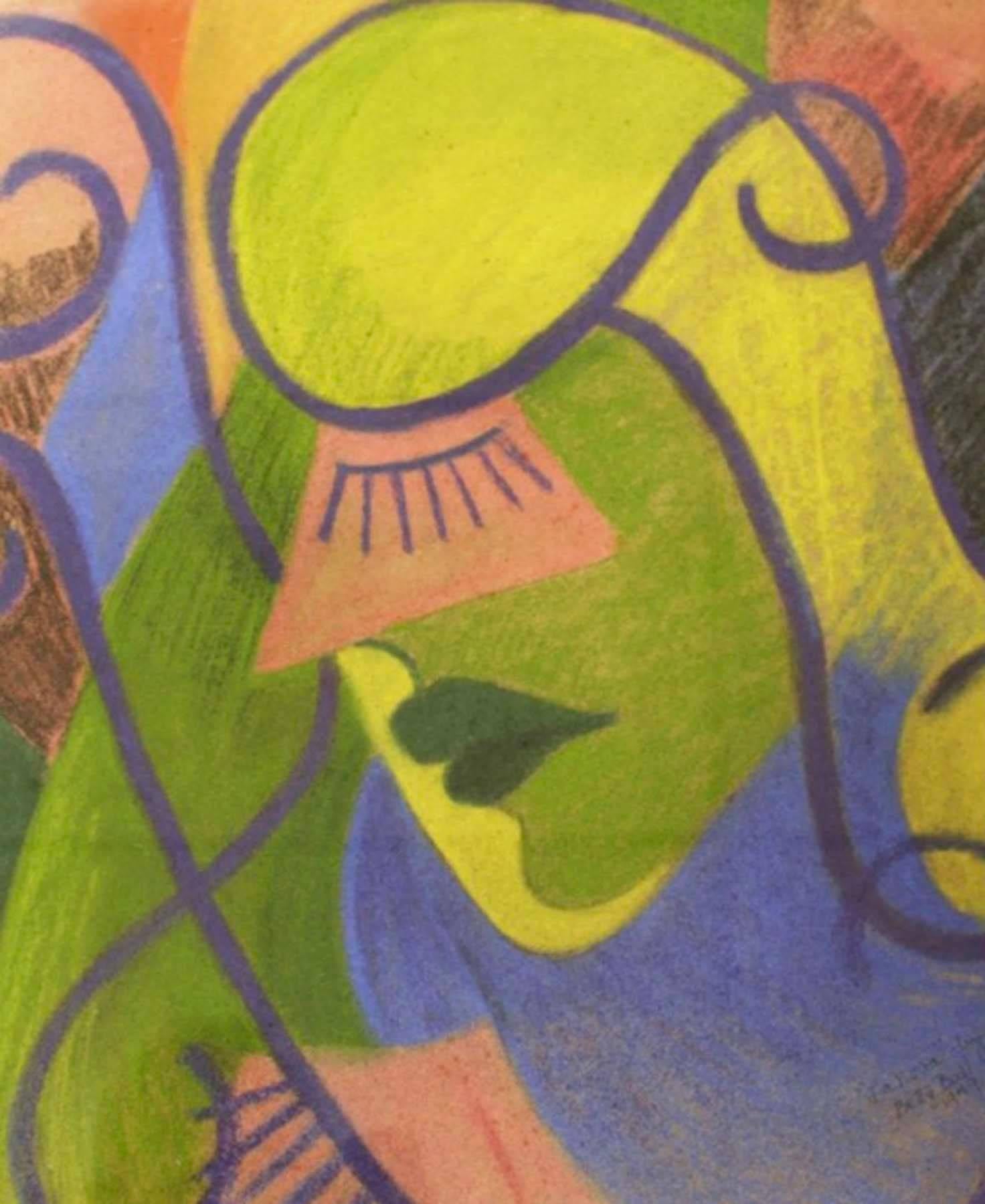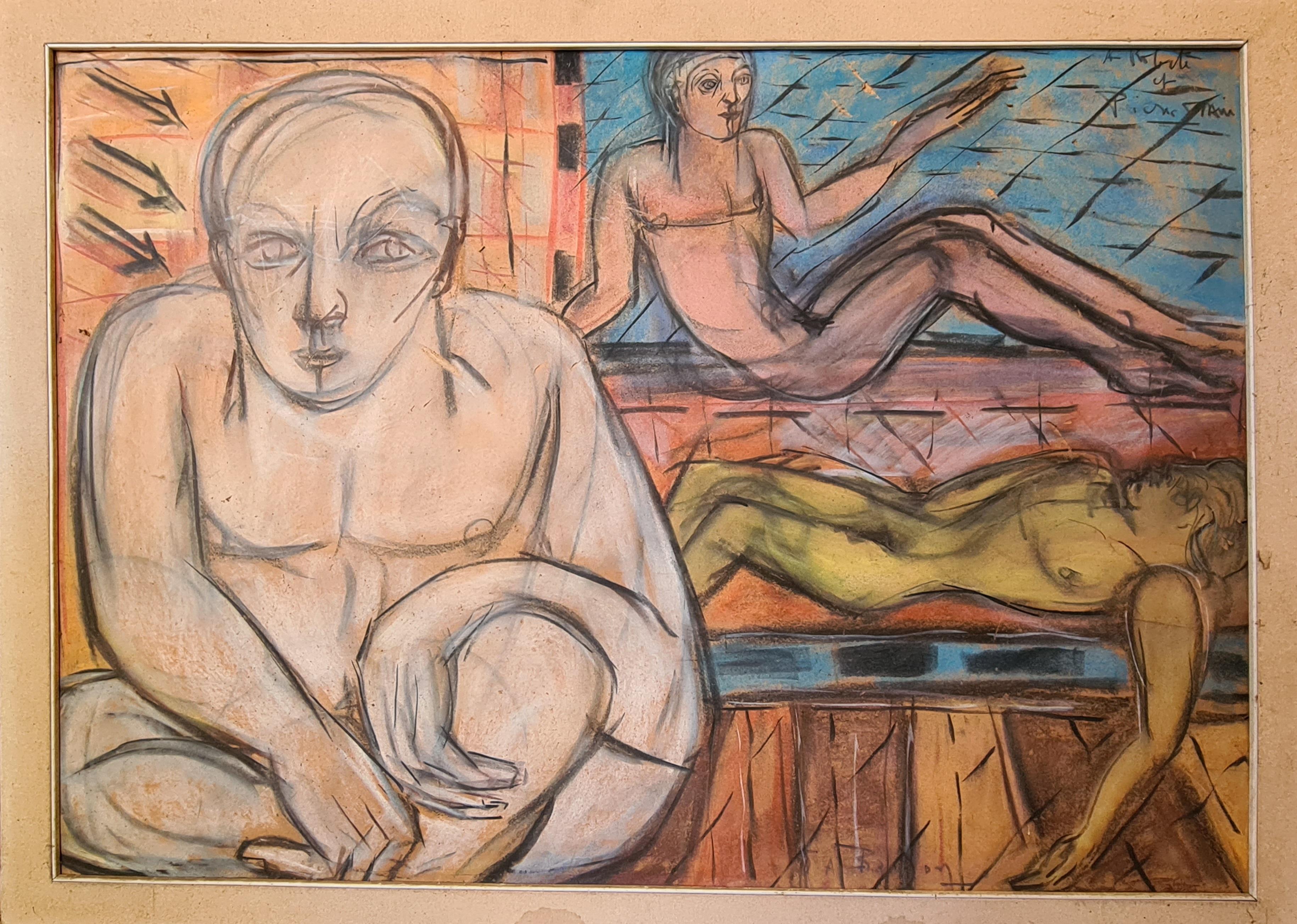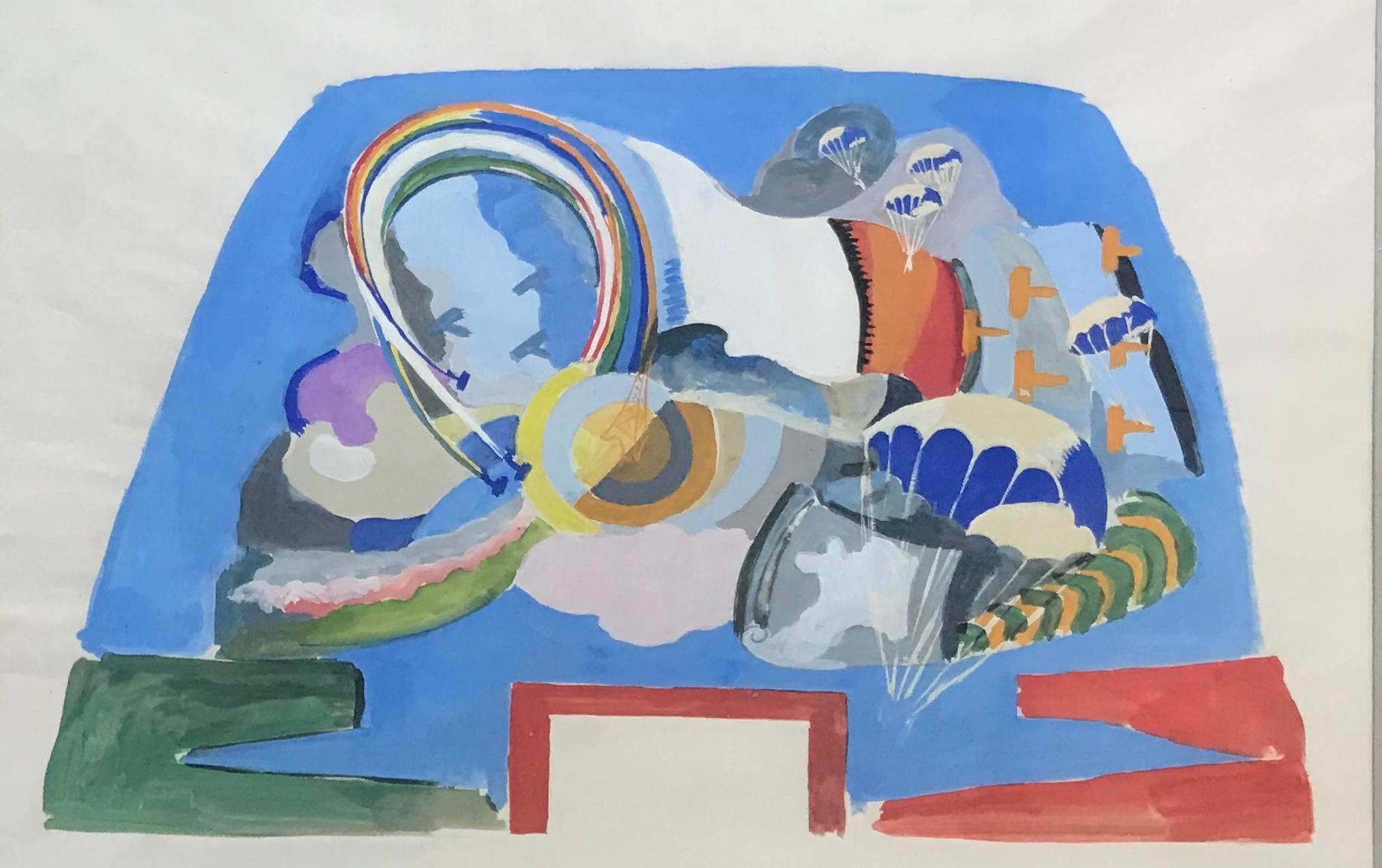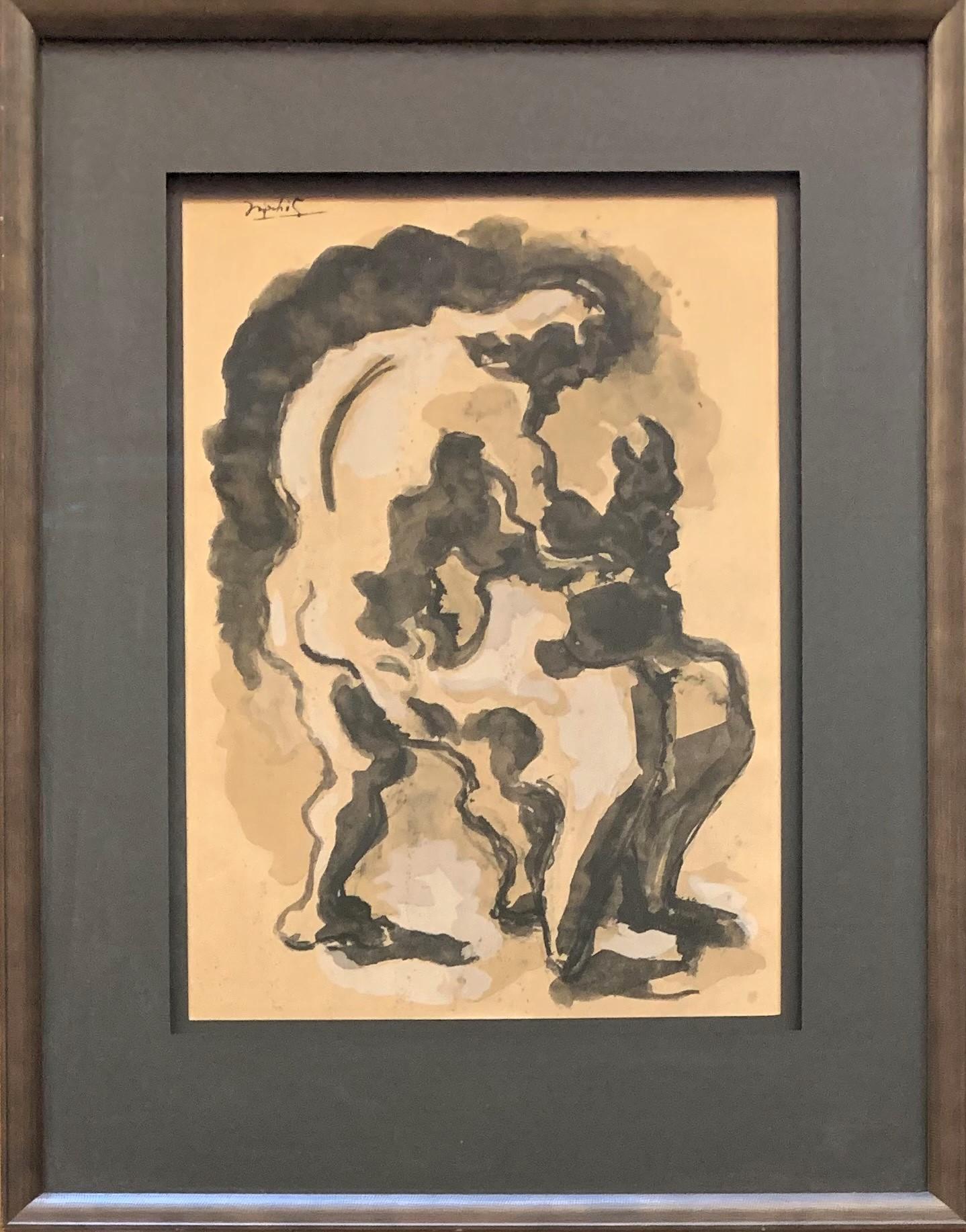Items Similar to Two Seated Nudes, Surrealist Gouache by Handel Evans
Want more images or videos?
Request additional images or videos from the seller
1 of 6
Handel EvansTwo Seated Nudes, Surrealist Gouache by Handel Evans1972
1972
About the Item
Artist: Handel Evans, British (1932-1999)
Title: Two Seated Nudes
Year: 1972
Medium: Gouache on Paper, signed and dated l.r.
Size: 9.5 x 12.5 in. (24.13 x 31.75 cm)
Frame: 17.25 x 20.25 inches
- Creator:Handel Evans (1932 - 1999, British)
- Creation Year:1972
- Dimensions:Height: 17.25 in (43.82 cm)Width: 20.25 in (51.44 cm)
- Medium:
- Movement & Style:
- Period:
- Condition:
- Gallery Location:Long Island City, NY
- Reference Number:1stDibs: LU4661443623
About the Seller
4.8
Platinum Seller
These expertly vetted sellers are 1stDibs' most experienced sellers and are rated highest by our customers.
Established in 1979
1stDibs seller since 2014
2,695 sales on 1stDibs
Typical response time: <1 hour
- ShippingRetrieving quote...Ships From: Long Island City, NY
- Return PolicyA return for this item may be initiated within 7 days of delivery.
More From This SellerView All
- Kneeling NudeBy Mikhail TurovskyLocated in Long Island City, NYArtist: Mikhail Turovsky, Russian (1933 - ) Title: Kneeling Nude Year: circa 2000 Medium: Gouache and oil on paper, signed lower right Paper Size: 25.5 ...Category
Early 2000s Modern Figurative Paintings
MaterialsOil, Gouache
- "Damas", Framed Painting by Salvador Valdes GalindoBy Salvador Valdes GalindoLocated in Long Island City, NYArtist: Salvador Valdes Galindo, Mexican Title: Damas Year: Circa 2000 Medium: Gouache on Panel, signed lower right Size: 23 x 15 inches Frame Size: 33.5 x 25.5 inchesCategory
Early 2000s Contemporary Figurative Paintings
MaterialsGouache
- Men Playing Cards, Painting by Joseph MarguliesBy Joseph MarguliesLocated in Long Island City, NYAn original Gouache painting measuring 16 x 20 inches by Joseph Margulies. The painting is signed lower right. Born in Vienna, Joseph Margulies becam...Category
1960s American Impressionist Figurative Paintings
MaterialsBoard, Gouache
- Dice, Gouache Painting by Alexander Calder 1974By Alexander CalderLocated in Long Island City, NYArtist: Alexander Calder Title: Dice Year: 1974 Medium: Gouache on Canson Lavis Paper, signed and dated lower right (titled, verso) Paper Size: 29 x 42 inches Frame: 37 x 51 inches ...Category
1970s Modern Figurative Paintings
MaterialsGouache
- Statuette au Vase Jaune, painting by Fernand Leger c.1949By Fernand LégerLocated in Long Island City, NYArtist: Fernand Leger, French (1881 - 1955) Title: Statuette au Vase Jaune Year: circa 1949 Medium: Gouache on Paper, dedicated (a Nicole) l.r. Size: 5 x 5 ...Category
1940s Modern Figurative Paintings
MaterialsGouache
- Restaurant Scene with BandBy Robert PhilippLocated in Long Island City, NYArtist: Robert Philipp, American (1895 - 1981) Title: Restaurant Scene with Band Medium: Oil on Canvas, signed l.r. Size: 12 x 15 in. (30.48 x 38.1 cm...Category
Mid-20th Century Impressionist Figurative Paintings
MaterialsGouache
You May Also Like
- Cyberurban en tondo (L1). Architectural futurist landscape inspired in Bauhaus .Located in Segovia, ESCiberurban in "tondo". Architectural colorful landscape inspired in the Bauhaus School. Acrylic paint, mixed media on panel. 2021 Dimensions in cm.: 132 x 129 x 4 cm. In inches: 51.9...Category
2010s Futurist Figurative Paintings
MaterialsMixed Media, Acrylic, Wood Panel
- LA NOVABy Betty BallLocated in Los Angeles, CABETTY BALL "LA NOVA" PASTEL, SIGNED AMERICAN, DATED 1949 18 x 14 InchesCategory
1940s Futurist Figurative Paintings
MaterialsPastel, Paper
- Futurist, Novecento Italiano, Mid Century Italian Painting, Figures at the BathsBy Anselmo BucciLocated in Cotignac, FRMid 20th Century Italian Futurist, Novecento Italiano, work on paper, signed bottom right and with dedication top right (see photos). The subject is bathers enjoying the delights of a spa and sauna with colourful tiling to the background. The classical figures languorously positioned in repose but the central 'white' figure in stark contrast. The play on colours gives the work a vibrancy. The drawing is possibly a preparatory sketch for a larger work or mural. A vibrant, exciting and colourful work incorporating the styles of Futurism and the Novecento Italiano movement and with the influences or artists such as Anselmo Bucci, Adami, Jean Helion, Maryan, Achille Funi and Ugo Guidi. Anselmo Bucci was born in 1887 in Fossombrone in the district of Pesaro. Even though he studied Classics, right from a tender age he showed a talent for drawing and, when his parents moved near to Florence, he was taught by the artist Francesco Salvini. In 1904 the family settled in Monza and so the boy was able to study for a year at the Accademia di Belle Arti di Brera, but he did not follow up this educational experience and in 1906 he left Italy for Paris where he came into contact with the Parisian avant-garde, met fellow Italian artists such as Severini and Modigliani, and made friends with Picasso, Utrillo and Apollinaire. In 1907 he showed a painting at the Salon, but these Parisian years were most important for his love of engraving techniques – etching and dry point that enabled him to fully develop his themes characterised by movement. On the outbreak of war in 1915 he returned to Italy and he enlisted in the same battalion as several Futurist artists such as Martinetti, Boccioni, Sant’Elia and Carlo Erba. In 1914 he won the silver medal at the Mostra dell’Incisione (Exhibition of Engravings) at Florence. In 1917 in Paris he published pictures of war scenes entitled “Croquis du Front Italien”. In 1919 he printed twelve lithographs entitled “Finis Austriae” again showing events from the war. At the end of the war he lived between Milan and Paris and he dedicated his time completely to his art with personal exhibitions, exhibiting at all the most important Italian and French shows, in Belgium, Holland and England. In 1922, he established the group “Movimento del Novecento”, (Novecento Italiano), (20th century Movement) a joint venture with the artists Sironi, Funi, Oppi, Malerba, Dudreville and Marussig. Their aim was to return to figurative art in contrast with the growing extremism of the Avant-gardists. In 1925 he worked on the illustration of the first edition of Kipling’s The Jungle Book producing eight dry point plates. In the early 30’s he lived in Bucci, Trieste, where he worked on the furnishing of the steamships for the Trieste Navigazione Libera, at the same time he continued to work on many book illustrations. During the second European war he adapted to being a war artist recording the events of the war as he had done previously. Indeed the engravings depicting battles of the Marines and the Air Force belong to this period. In 1945, following the bombing of his house in Milan, he returned to Monza to his father’s home where he remained until his death. Futurism was an Italian art movement of the early twentieth century that aimed to capture in art the dynamism and energy of the modern world. Futurism was launched by the Italian poet Filippo Tommaso Marinetti in 1909. On 20 February he published his Manifesto of Futurism on the front page of the Paris newspaper Le Figaro. Among modernist movements futurism was exceptionally vehement in its denunciation of the past. This was because in Italy the weight of past culture was felt as particularly oppressive. In the Manifesto, Marinetti asserted that ‘we will free Italy from her innumerable museums which cover her like countless cemeteries’. What the futurists proposed instead was an art that celebrated the modern world of industry and technology: We declare…a new beauty, the beauty of speed. A racing motor car…is more beautiful than the Victory of Samothrace. (A celebrated ancient Greek sculpture in the Louvre museum in Paris.) Futurist painting used elements of neo-impressionism and cubism to create compositions that expressed the idea of the dynamism, the energy and movement, of modern life. Chief artists associated with futurism were Giacomo Balla, Umberto Boccioni, Gino Severini. After the brutality of the first world war, many artists rejected the avant-garde notions of futurism and other pre-war movements, by using more traditional and reassuring approaches, a phenomenon described as the ‘return to order’. Novecento Italiano was founded by Anselmo Bucci (1887–1955), Leonardo Dudreville (1885–1975), Achille Funi, Gian Emilio Malerba (1880–1926), Pietro Marussig, Ubaldo Oppi, and Mario Sironi. Motivated by a post-war "call to order", they were brought together by Lino Pesaro, a gallery owner interested in modern art, and Margherita Sarfatti, a writer and art critic who worked on Italian dictator Benito Mussolini's newspaper, The People of Italy (Il Popolo d'Italia). Sarfatti was also Mussolini's mistress. The movement was officially launched in 1923 at an exhibition in Milan, with Mussolini as one of the speakers. The group was represented at the Venice Biennale of 1924 in a gallery of its own, with the exception of Oppi, who exhibited in a separate gallery. Oppi's defection caused him to be ejected from the group, which subsequently split and was reformed. The new Novecento Italiano staged its first group exhibition in Milan in 1926. Several of the artists were war veterans; Sarfatti had lost a son in the war. The group wished to take on the Italian establishment and create an art associated with the rhetoric of fascism. The artists supported the fascist regime and their work became associated with the state propaganda department, although Mussolini reprimanded Sarfatti for using his name and the name of fascism to promote Novecento. The name of the movement (which means 1900s) was a deliberate reference to great periods of Italian art in the past, the Quattrocento and Cinquecento (1400s and 1500s). The group rejected European avant garde art and wished to revive the tradition of large format history painting in the classical manner. It lacked a precise artistic programme and included artists of different styles and temperament, for example, Carrà and Marini. It aimed to promote a renewed yet traditional Italian art. Sironi said, “if we look at the painters of the second half of the 19th century, we find that only the revolutionary were great and that the greatest were the most revolutionary”; the artists of Novecento Italiano “would not imitate the world created by God but would be inspired by it”. Despite official patronage, Novecento art did not always have an easy ride in Fascist Italy. Mussolini was personally uninterested in art and divided official support among various groups so as to keep artists on the side of the regime. Opening the exhibition of Novecento art in 1923 he declared that “it is far from my idea to encourage anything like a state art. Art belongs to the domain of the individual. The state has only one duty: not to undermine art, to provide humane conditions for artists, to encourage them from the artistic and national point of view." The movement was in competition with other pro-Fascist movements, especially Futurism and the regionalist Strapaese movement. Novecento Italiano also met outright opposition. Achille Starace, the General Secretary of the Fascist Party, attacked it in the Fascist daily press and there was virulent criticism of its “un-Italian" qualities by artists and critics. In the 1930s, a group of professors and students at the Accademia di Brera established an opposition group to Novecento Italiano. Among them was the director of the academy Aldo Carpi, and students Afro, Aldo Badoli, Aldo Bergolli, Renato Birolli, Bruno Cassinari, Cherchi, Alfredo Chighine, Grosso, Renato Guttuso, Dino Lanaro, Giuseppe Migneco, Mantica, Ennio Morlotti, Aligi Sassu, Ernesto Treccani, Italo Valenti, and Emilio Vedova (and later Giuseppe Ajmone...Category
Mid-20th Century Futurist Figurative Paintings
MaterialsPaper, Pastel, Crayon, Pencil
- Study fot he tronconic hall of the Air Palace, 1937. Gouache on paper.Located in Paris, FRStudy fot he tronconic hall of the Air Palace, 1937. Gouache on paper. This is a study most this artist's most important artistic work. Son of the painter Albert Aublet, Felix enrol...Category
1930s Cubist Figurative Paintings
MaterialsGouache
- Prometheus Conquering the Vulture, Gouache Painting, Modern & Cubist 1938By Jacques LipchitzLocated in Saint Augustine, FLArtist: Jacques Lipchitz (1891-1973, French) Title: Prometheus & the Vulture Medium: Gouache & Pencil on Paper Movement: Modern, Cubist Year of Work: Circa 1938 Signature: Top Left ...Category
1930s Modern Figurative Paintings
MaterialsPaper, Pencil, Gouache
- Jacques Lipchitz - Prometheus, Original Gouache PaintingBy Jacques LipchitzLocated in Saint Augustine, FLLipchitz’s reputation for being a painterly Cubist sculptor is understood through his semi-abstract paintings like “Prometheus”. His use of monochrome gouache to create distorted figures from the negative spaces is distinctive. Jacques Lipchitz was a celebrated Lithuanian-born French sculptor best known for his Cubist works...Category
1920s Cubist Figurative Paintings
MaterialsGouache
Recently Viewed
View AllMore Ways To Browse
Seat Art
Vintage Two Seater
British Seats
Retro Futurist Art
Vintage British Nudes
Signed Handel
Face Picasso
African Painting Large
Art Bicycle
Bicycle Art
African American Art Oil
Painting Of Mother And Children
Paintings Of Mothers And Children
Girls In Woods
Vintage American Van
Panel Symbol
Woman In Garden
Western Indian Art




